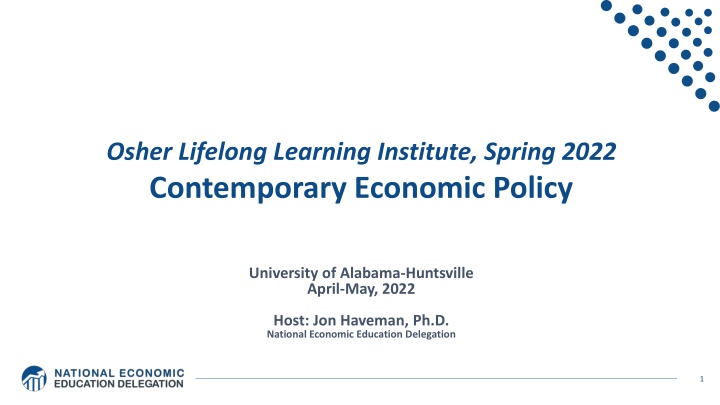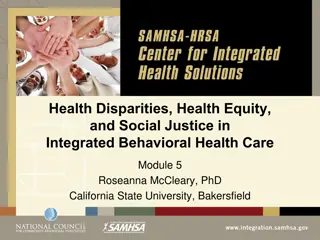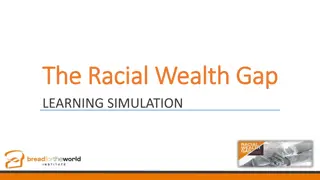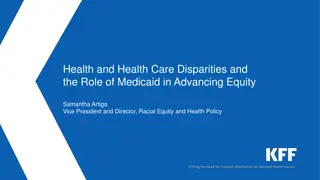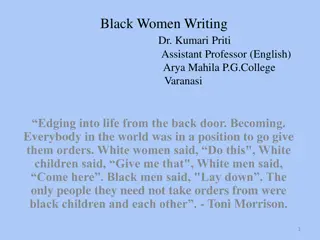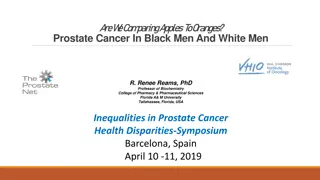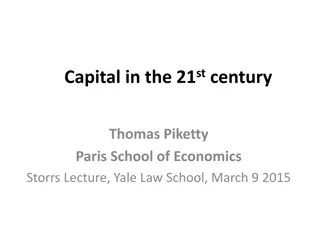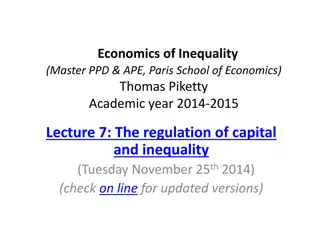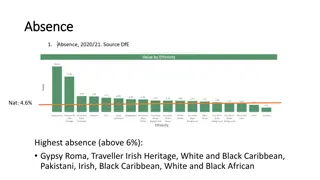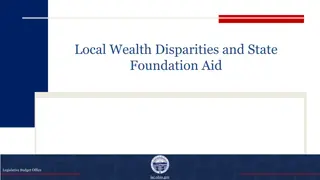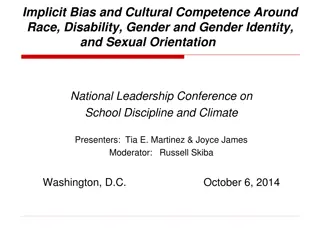Contemporary Economic Policy: Black-White Wealth Disparities & Solutions
Delve into the complexities of the Black-White wealth gap in the context of contemporary economic policy. Explore evidence, implications, and potential solutions to address this critical issue affecting societal inequalities.
Download Presentation

Please find below an Image/Link to download the presentation.
The content on the website is provided AS IS for your information and personal use only. It may not be sold, licensed, or shared on other websites without obtaining consent from the author.If you encounter any issues during the download, it is possible that the publisher has removed the file from their server.
You are allowed to download the files provided on this website for personal or commercial use, subject to the condition that they are used lawfully. All files are the property of their respective owners.
The content on the website is provided AS IS for your information and personal use only. It may not be sold, licensed, or shared on other websites without obtaining consent from the author.
E N D
Presentation Transcript
Osher Lifelong Learning Institute, Spring 2022 Contemporary Economic Policy University of Alabama-Huntsville April-May, 2022 Host: Jon Haveman, Ph.D. National Economic Education Delegation 1
Available NEED Topics Include: Coronavirus Economics Immigration Economics US Economy Housing Policy Climate Change Federal Budgets Economic Inequality Federal Debt Economic Mobility Black-White Wealth Gap Trade and Globalization Autonomous Vehicles Minimum Wages US Social Policy 2
Course Outline Contemporary Economic Policy - Week 1 (4/11): US Economy & Russia/Ukraine Conflict - Week 2 (4/18): Trade and Globalization (Alan Deardorff, University of Michigan) - Week 3 (4/25): The Black-White Wealth Gap (Stephanie Seguino, Univ. of Vermont) - Week 4 (5/2): Economic Mobility (Kathryn Wilson, Kent State University) - Week 5 (5/9): Cryptocurrencies and the Future of Money (G. Woglom) - Week 6 (5/16): Autonomous Vehicles (Jon Haveman, NEED) 3
Submitting Questions Please submit questions in the chat. - I will try to handle them as they come up, but may take them in a bunch as time permits. We will do a verbal Q&A once the material has been presented. - And the questions in the chat have been addressed. 4
The Black-White Wealth Gap Stephanie Seguino, Ph.D. University of Vermont April 25, 2022 5
Outline Evidence of disparities Why wealth is important Sources of disparities Implications of disparities Policy solutions 6
What is Wealth? Income vs Wealth - Income is the flow of funds into a households each year. - Wealth is a household s NET asset holdings. o The value of all assets minus the value of all debts. o Assets can be financial and physical. Assets include: - Owned homes, cars, stocks, businesses, savings and checking accounts, pensions, life insurance Debts include: - Home mortgages, car loans, credit cards, and any other significant financial obligations (excl regular bills) 7
Evidence 8
Overall Wealth Distribution 2019 Overall Median: $121,700 9
Wealth is More and More Concentrated 99th Percentile 2016 = 7x 1963 11 Source: Urban Institute
How do we accumulate wealth? Savings from income. Earnings from the ownership of financial assets like stocks and bonds (interest). Appreciation of value of assets such as housing or stocks and bonds. Inheritance.
Wealth Disparities, 2019 Ratio of Shares (Share of Wealth/Share of Families Race/Ethnicity Mean Wealth Share of Families Share of Wealth White, non-Hispanic $983,400 64.9 85.3 1.3 Black, non-Hispanic $142,500 14.2 2.7 0.2 Hispanic or Latino $165,500 9.6 2.1 0.2 Other or Multiple Race $657,200 11.3 9.9 0.9 13 Source: Federal Reserve, Survey of Consumer Finances
Evidence of the Gap Mean is 7x Greater Median is 8x Greater 14
Net Worth by Age and Race 16 Source: https://www.brookings.edu/blog/up-front/2020/02/27/examining-the-black-white-wealth-gap/
Black Household Incomes Relative to White 17 Source: pewsocialtrends.org
Black Household Incomes Relative to White 18 Source: pewsocialtrends.org
Widespread Household Wealth Pays Dividends To individuals in the household - Choices/Agency - Wealth is iterative And to broader society - Human capital development - Entrepreneurship and innovation 22
Household Level Benefits Choices/Life Agency - Finance higher education - Living in good neighborhoods - Saving for retirement - Capital to start a business - w/stand financial hardship - Better legal counsel - Exert political influence - Finance costly medical procedure - Bequests Wealth is iterative - Wealth begets more wealth. o Access to higher return investments. - Wealth transfers across generations. o Wealth is sticky. 23
Parental Wealth is Important Important pre-estate transfer effects on kids: - Influences human capital accumulation. - Influences the returns to education. - Adult incomes of offspring. There are clearly enormous differences in wealth held by parents of Black and White children. 24
Tangible Benefits for the Broader Economy More human capital development Increased entrepreneurship Greater labor force participation Healthier labor force Less social unrest Less reliance on social programs Smaller stock of student loans 26
Events/Policies with Direct Wealth Implications Slave trade - The first deprivation. Slavery 40 acres (and a mule) - The second deprivation. - Discriminatory distribution of land. Freedmen s Bank - Lax oversite and dissolution. Jim Crow Laws & Economic Policy - Convict leasing, debt peonage, chain- gang, sharecropping, and lynching. Homestead Act - Discriminatory distribution of land. Land theft and destruction - E.g., Black Wall Street Tulsa, 1921. GI Bill - Discriminatory access Levittown Federal Housing Authority - Redlining Mortgage interest tax deductions 28
Results for Black Families Much lower accumulation of wealth than among White families. Implications: - Less financial contribution from parents to children. o More difficult access to higher education. o Less access to capital for business formation. - More likely to live in disadvantaged neighborhoods. o Segregation tax o Less access to quality education. - Disparities in availability of resources to build wealth. 29
Potential Explanations: Differences in Educational attainment Home ownership Increased savings Financial literacy Entrepreneurship Wages Family structure Initial endowment 30
Wealth by Educational Attainment Educational Attainment Net Worth Median Net Worth Mean 71.0% No High School $22,800 $157,200 High School $67,100 $249,600 Some College $66,100 $340,600 16.1% College $292,100 $1,511,100 8.6% 4.3% 31 Source: Federal Reserve Board, Table data are 2016.
Educational Attainment: Policy How do we increase educational attainment? - Increase universal quality of public schools. - Increased/improved counseling in high schools. - Reduce costs (including living) of attending college. - Increased access to funds for education. - Make publicly available pre-k education. - Mandate kindergarten by age 5. - No one able to drop out before age 18 or at least 11 completed years of education. 32
Educational Attainment Median Household Net Worth by Race and Education 33 Source: Darity, et al., What We Get Wrong About Closing the Racial Wealth Gap.
Home Ownership Net Worth Median Net Worth Mean Housing Status Renters $5,200 $91,100 Owner $231,400 $1,034,200 35
Wealth Equality Through Home Ownership? Well-documented evidence of historical and ongoing housing and lending discrimination. - Appraisals, buyers, lenders, local laws, covenants What about home prices in minority neighborhoods? Even if they buy, they won t get the appreciation of White neighborhoods. - Home values are 50% lower in majority Black neighborhoods. o 23% after adjusting for quality and amenities. o Called the segregation tax. 36 Source: Brookings, Home ownership while black
What Determines Differences in Home Ownership? Wealth of parents Ability to borrow lending discrimination - At all - On equivalent terms to white borrowers Local ordinances housing discrimination Lower appreciation rates of homes in majority Black communities - This makes it a less attractive investment. 37
Increased Savings Historical evidence generated by economists ranging from Milton Friedman (1957) to Marjorie Galenson (1972) to Marcus Alexis (1971) to Gittelman and Wolff (2004) .. - All find that after accounting for household income, Blacks have a slightly higher savings rate than Whites. 38
Financial Literacy Financial literary helps explain individual wealth differences within racial groups, but none of the wealth differences between racial groups. - The insufficient financial literacy argument is often leveled specifically at Black households. o The argument holds equally with regard to all households of comparable incomes. Controlling for household income, there is no difference in rates of asset appreciation between Black and White households. 39
Entrepreneurship: Rate of New Entrepreneurs 40 Source: Statistica
Explaining Differences in Entrepreneurship Disparities in access to capital: - Wealth disparities o Specifically, differences in home equity. o Differences in wealth levels of friends and family. - Less likely to rely on banks and more likely to rely on credit cards. - Loans have higher int rates and more likely to be declined. - Less access to venture funds. Previous business ownership by family. 41
Wage Gap: Controlling for education, age, job type. 42 Source: https://www.frbsf.org/economic-research/publications/economic-letter/2017/september/disappointing-facts-about-black-white-wage-gap/
Black-White Earnings Gap by Education 43 Source: https://www.frbsf.org/economic-research/publications/economic-letter/2017/september/disappointing-facts-about-black-white-wage-gap/
Wage Gap Broken Down 44 Source: https://www.frbsf.org/economic-research/publications/economic-letter/2017/september/disappointing-facts-about-black-white-wage-gap/
Equality of Income = Equality of Wealth / 45 Source: http://hartfordinfo.org/issues/wsd/FamiliesandChildren/Racial-Wealth-Gap-Brief.pdf
Over (under) representation of racial groups in prison Racial share in prison/Racial share of US population 4.5 4.2 4.0 3.6 3.5 3.1 3.0 2.6 2.6 2.5 Whites 2.0 Blacks 1.5 Hispanics 1.2 0.8 0.8 0.8 1.0 0.7 0.7 0.6 0.6 0.6 0.4 0.5 0.0 Jail incarceration Death row population State & federal incarceration Life without parole sentence Life sentence
What is Fundamentally Responsible? Individual behaviors? Structural characteristics of the economy? History policy and otherwise? 50
